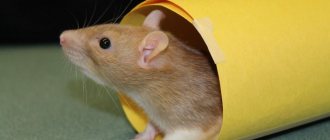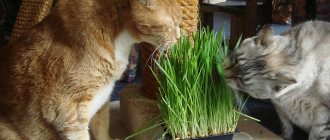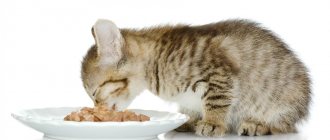How to choose a breed for breeding?
First of all, choose the one you like. Just keep in mind - the more exotic the breed, the more the breeding kitten costs and the greater the chance that you will come across an animal with problems. Inbreeding is a delicate matter, and some hereditary diseases are not immediately detected. A rare breed means either very close inbreeding or the purchase of a manufacturer abroad.
There are breeds of cats in which a predisposition to certain diseases is inherited from their parents. Therefore, be sure to find out whether the breed you have chosen has such a problem and whether the owners of the breeders carried out the necessary tests. For information, go to breed forums, felinologist courses on a particular breed, or to veterinarians.
Where to start breeding cats
Breeding cats is the same type of business as trade, provision of services for transporting people or goods, and many others. And before you start it, you need to decide on your goals, costs and capabilities.
The following thoughts usually push people to start this activity:
- Breeding will bring sufficient profit. Usually these are the owners of a purebred animal. Having purchased it for a sufficiently large fee, they decide to recoup the costs.
- I would like to give my cat the opportunity to give birth. Many owners mistakenly believe that the female must give birth once or twice and then she will calm down and will not demand a cat.
- Pedigree breeding will help develop a new breed or improve an existing one. Amateurs are not bothered by such problems. Those who decide to do this are most likely real professionals.
If the decision to breed cats is supported by a clearly justified goal, then it is necessary to estimate the upcoming costs.
Business advertising
If your pets are ready for sale, you should conduct a competent advertising campaign. There are several options to help you inform potential buyers.
Advertising in the media. You can place an ad in the newspaper for the sale of purebred cats. The advertisement should include detailed information about the breed, the cost of the kitten, and contact numbers to contact you.
Internet advertising. You can place your ad on a popular website. Most people look for information about purchasing animals there. You can also create your own website selling purebred cats.
Matings, pregnancy, birth, care of kittens before their sale
Usually, upon reaching 7–8 months of age, pets are already capable of procreation. The most reliable evidence of their body’s readiness to bear and give birth to kittens is the first heat. However, it is recommended to breed cats for the first time no earlier than 1.5 years. You need to look for a partner for mating (if there was no goal of purchasing a cat pair) in advance in special clubs, at exhibitions or through private advertisements.
Only absolutely healthy, vaccinated and dewormed animals are allowed to participate in this procedure. Mating should take place in a calm environment. If problems arise, you need to be able to help the cat. The duration of a meeting between a four-legged gentleman and a lady is on average 3–5 days.
Pregnancy lasts about 6–8 weeks. It is recommended to isolate a pregnant cat from other inhabitants of the cattery. The expectant mother requires special care and nutrition. If problems arise during the process of bearing cubs (prolonged lack of appetite, uncontrollable vomiting, lethargy, etc.), you should immediately call a veterinarian. The desire to create a “nest”, licking of the genitals, anxiety, swelling of the mammary glands are harbingers of childbirth.
Usually cats give birth on their own, but you need to be able to help them if necessary. New four-legged mothers, who need to be isolated from other animals, take care of the babies and teach them independence. If for some reason she cannot feed the cubs, they are transferred to artificial feeding with ready-made formulas for feeding kittens, dry formulas for children, or self-prepared mash. This should be done every 2 hours. 4 weeks of age is the optimal time for the first feeding.
The kitten is ready for sale after it reaches 3 months. Until this moment, he must be vaccinated, pre-treated against worms, activated or registered depending on which system the club belongs to, and metrics done.
What should you do first?
- Visit an exhibition where as many cats of your breed are presented as possible. Take a closer look at the manufacturers, talk to the breeders. Don’t take money so you won’t be tempted to buy a kitten right at the show! Get to know the breeders better, write down the coordinates of the ones you like, check the prices for kittens and the terms of purchase.
- Go to the pet store's website. Look at scratching posts, beds, and other accessories for cats. Take a closer look at super-premium food. Find out prices, read reviews. Make a list of preliminary expenses.
- An optional, but desirable option is to take a felinologist course at a large club that has a specialist in your breed. During the courses, you will find out all the subtle points. Ask veterinarians, who often conduct seminars on the basics of veterinary care at such courses, to find out the prices for treatment. Get a certificate.
If there is no desire to run away, the first stage has been completed. And only now go get the kitten.
Pitfalls when breeding animals
In pursuit of profit, you will have to work hard. Animal breeders are forced to devote all their time to them, and the more cats you have, the less time you have for everything else. When starting your business, you will have to invest a lot. For example, a purebred Maine Coon will cost 20 thousand rubles and more , it depends on the specific nursery and the prospects of the kitten itself. Breeders usually sell at a higher price for breeding. Here, of course, you can cheat and say that you are taking a cat for the family, but in any case you will need a pedigree and permission to breed if you want the kittens to sell at a high price.
Choosing a future manufacturer
Keep in mind that prices for pet, breed and show class kittens may vary. There is no need to try to save money by buying a cat “for the sofa” and then letting him breed. First of all, it's not decent. The breeder will be unhappy. Secondly, “for the sofa”, even with a pedigree, they often sell not the best representatives of the breed. Perhaps the animal has hidden defects. So look for a cat of at least “breed” class, and a cat of “show” class. The requirements for stud cats are stricter than for cats.
If you have already spent a little time among breeders, then you have probably found a suitable nursery that sells quality kittens. A kitten will be able to move to a new home only after reaching a certain age and having been vaccinated. But you can reserve the baby you like by paying a deposit. And be sure to conclude a purchase and sale agreement.
The kitten comes with:
- veterinary passport with a note on the vaccinations done (it is better if there are two records. If there is only one, you will have to take care of the second vaccination yourself);
- metric or pedigree, if the breeder has already obtained it on his own. If there is only a metric, the pedigree is issued by the club in which the litter was registered. Attention! Pedigree and permission to breed are two different things. The pedigree only confirms the origin of a kitten from parents of a certain breed, but not its breeding value;
- recommendations from the breeder on feeding, training, the best choice of doctor, etc. If possible, ask for them to be provided to you in writing. It is very easy to forget something important, and it will be easier for you later.
If you want to feed your kitten natural products rather than ready-made food, you will need special vitamin and mineral complexes that are added to the cat's food. They maintain the activity and resistance of the animal’s body to viruses, and normalize the balance of vitamins in the body. For example, the Radostin vitamin and mineral complex, produced in 5 types, can be used for additional care for a pet of any breed and age.
Cat lovers club "Moscow"
Have you purchased or are you planning to purchase a purebred kitten or want to breed? Don't know where to start? This article contains the main stages and rules of breeding.Choosing a kitten
If you are buying a kitten for breeding, you must approach the choice of a kitten completely differently than when choosing just a pet. Your pet must be healthy and you personally like it, that’s enough. A kitten for breeding is a completely different matter.
Before you buy a kitten for breeding, you should first get to know the chosen breed in as much detail as possible, carefully study the characteristics of the breed, find out the advantages and disadvantages, and most importantly, see with your own eyes as many cats of this breed as possible. Your choice should not be random, but conscious
— You must understand what the breed advantages and disadvantages of the kitten you have chosen are, what grades and titles the kitten can receive at exhibitions, and what kind of offspring will be born from this kitten when he/she becomes an adult.
KLK "Moscow" strongly recommends that both buyers and breeders enter into a written contract for the purchase and sale of a kitten, regardless of the price of the kitten and the purpose of the purchase - for breeding or as a pet. The agreement will allow you to avoid mutual claims in the future. If a kitten is purchased for breeding, a written purchase and sale agreement is required! A sample contract for the sale and purchase of a kitten is available on the Club Documents page
What class should a kitten belong to - show, breed, pet... >>>>>>
Registration of pedigree
A purebred kitten differs from a purebred kitten by expressed breed characteristics and the presence of a pedigree, which certifies the origin of the kitten from purebred parents.
A pedigree for a cat is like a passport for a person.
When purchasing a kitten for breeding, immediately find out how you will obtain the pedigree and how much it will cost. There are different options - some breeders order pedigrees for kittens themselves and give them to the buyer along with the kitten. Others give the buyer a metric - an analogue of a human birth certificate.
The metric must contain the following data:
• kitten's name, date of birth, gender, color; • name and contacts of the club that issued the metrics; • first name, last name and contact details of the breeder who sold you the kitten; • seal of the club or nursery.
To obtain a pedigree, the buyer must take or mail the pedigree to the cat fancier club that issued it.
, and pay for the production of the pedigree.
PLEASE NOTE: The pedigree only certifies the origin of the kitten from purebred parents, but is not evidence of breeding value or permission for breeding!
Raising a kitten
If you plan to use your pet for breeding, you must create the best conditions for him.
Giving birth and feeding kittens is a serious burden on a cat’s body. It is unacceptable to feed a breeding cat with cheap food or leftovers from your table; premium food is required. Only a healthy, well-groomed cat will give birth to healthy, strong kittens.
Proper raising of a future breeding cat is no less important, because... a stud cat must be in perfect physical shape, otherwise he will have no brides.
In addition, the appearance of the animal and the condition of the coat are of great importance for victories at exhibitions.
Joining the club
Main functions of the Cat Lovers Club:
• Preparation of felinological documents for club members: metrics or pedigrees for kittens of club members, nurseries for club members, title certificates for adult cats and cats of club members, etc.
• Holding cat shows. Each club regularly holds cat shows. Any cat owner can be a participant in any club's exhibition, regardless of membership in any club.
Catteries are engaged in breeding cats and kittens. The club prepares documents and holds exhibitions, but does not breed kittens. Nurseries unite into clubs; one club can consist of many nurseries: Kennels of KLK "Moscow"
Club members can post information on the club website - about their cattery, about kittens for sale, about cats for mating.
The club is a public non-profit organization whose activities are financed by contributions from club members. For example, in the Moscow Cultural Club, registration of a pedigree costs 1200-1500 rubles, a title certificate - 700 rubles, an annual fee - 600 rubles. Club members who have not paid the annual fee during the current year are considered to have terminated their membership in the club.
NOTE:
The club cannot in any way influence the health and breeding potential of the animal.
The club is not authorized to regulate the relationship between the buyer and the breeder in the event of illness or death of the animal, financial claims, or any other. The club also does not deal with mutual claims between two breeders in the event of mating. The club maintains only breeding documents, similar to the passport office.
In case of claims, breeders must act in accordance with the purchase and sale or breeding agreement. The club has neither the right nor the opportunity to understand the relationships of individuals who entered into these relationships without any participation of the club. If the situation cannot be resolved through negotiations, it is necessary to go to court, but this can only be done if there is a purchase and sale agreement.
Exhibitions
Pedigree cats and cats that are used for breeding must attend exhibitions and receive exhibition evaluations - these are the breeding rules. Nowadays in Russia cat shows are organized by clubs of cat lovers. Clubs are subject to different felinological systems; there are several such systems. Each system has its own rules for maintaining documentation, holding exhibitions, and features of obtaining exhibition ratings and titles. For more details, see Felinological systems.
Most clubs belong to one of the felinological systems, but there are also independent clubs that do not obey any felinological system, but have their own rules. KLK "Moscow" belongs to the WCF system, therefore in our activities we are subject to the rules of the WCF system.
Cat shows are held to evaluate the work of breeders by independent experts. Experts evaluate cats, compare them with the standard (breed ideal), as well as with each other. Cats receive various grades and titles. Experts select the best animals that are closest to the modern type in each breed. The best cats win the main competition of the exhibition - “Best in Show”, as well as in monobreed shows and WCF rings.
In addition, experts note the shortcomings of each cat so that this is taken into account in breeding. It is at the exhibition that the quality of the cat is confirmed, its compliance with the standard and level of breeding.
PLEASE NOTE: Only a positive exhibition assessment is permission for this cat (cat) to participate in breeding.
For more details, see Breeding status of the Moscow Cat Lovers Club, paragraphs. 4.1-4.6.
Examples of exhibition documents - diploma and evaluation sheet:
You can start your career from childhood - exhibit a cat and especially a female cat in the kitten class (3-6 months), then in the junior class (6-10 months), and from 10 months in the open class.
Starting from 10 months, exhibition scores are taken into account in the animal’s career - in the WCF there are 6 levels of the Championship. Estimates d.b. obtained sequentially, it is impossible to immediately obtain the maximum score. Every three ratings at the exhibition means another level, another title. For more details, see WCF Exhibition Classes, Rules for Obtaining Titles
Exhibition ratings in the kitten and junior classes are necessary for a preliminary assessment of the animal - you can see the prospects of your pet and decide whether to continue the competitive epic or quit the race. In addition, the kitten gets used to the exhibition atmosphere and acquires a calm “show” temperament. To obtain high titles and win competitions, the animal’s calm disposition and resistance to stress are a necessary condition.
Matings
After your cat reaches 12 months of age and receives a positive assessment from an expert, you can breed your pet. To find a future partner, exhibitions are very important - at the exhibition you can see “live” the cat you are interested in, and possibly his kittens, meet the owners, and find out the mating conditions. For a cat, an exhibition is a great opportunity to advertise itself, hand out business cards with a phone number and website address.
Usually matings are paid, and therefore it is recommended to conclude a mating agreement before mating in order to avoid mutual claims in the future. A sample mating agreement is available on the Club Documents page.
Birth of kittens
Pregnancy in cats lasts on average 65 days, counting from the first day of mating. In some cats, the gestation period can range from 58 to 70 days.
Typically, cat birth occurs without problems, but sometimes there are exceptions to this rule. Therefore, in the week when the cat is due to give birth, you will be required to provide 24-hour attention to her. Someone should always be nearby - it is better not to risk leaving the cat alone during childbirth. Some cats, especially young and inexperienced ones, do not know what to do with their kittens. Your absence during birth may cost you the life of your entire litter.
Often a kitten is born “with a shirt on”, and if an inexperienced cat does not lick it, it will suffocate. A nearby owner can solve this problem in a few seconds.
The mother cat provides full care for the kittens until approximately 3 weeks of age. Kittens should be kept in a warm and dry place. Starting from 3 weeks, you need to start feeding them and putting out a tray, which will require additional care from you. But when the kittens start walking, you should communicate with them more so that the kittens get used to people, adapt to the world around them and become real pets.
Kittens - litter activation
When the kittens are two months old, they can be registered in the club and felinological documents are issued for them - registered.
NOTE:
ACTIVATE and not ACTIVATE are completely different concepts. For more information, see the meanings of the words activate and activate.
During activation, a Breeding Certificate is issued for the litter, which is assigned a four-digit number in accordance with the current numbers in the Stud Book, and metrics are issued for the kittens. For more information about registration, see How to register the birth of kittens in the club.
After the birth of kittens in your home and the activation of your first litter, you become not just a cat owner, but also a breeder. If a cat lives in your house, then you are its owner, the owner of this cat at the moment. In this case, the breeder of your cat is the person in whose house she was born. If your cat has given birth to kittens, you are the breeder for those kittens, and their owners are usually other people.
Even if the new owner of your kitten assures that he is not interested in breeding and is buying the kitten as a pet, nevertheless give him the certificate with the contacts of the breeder and the club. Time passes and circumstances change. A kitten may change owners... It happens that a magnificent cat (cat) grows up and the whole family dreams of breeding, participating in exhibitions, but the problem arises “where is our pedigree?” Track the fate of your litter for at least a year.
Sincere wishes of health, success, well-being to the owners and breeders, and to our furry pets!
Care instructions
If you have one or more cats at home, you need to be well versed in their needs. Thus, a responsible breeder needs to monitor:
- Vaccinations - every cat must be vaccinated against rabies and dangerous infectious diseases (calicivirus, distemper, rhinotracheitis) once a year. Also, before selling kittens, the breeder is responsible for carrying out the first vaccination for each of them and obtaining a veterinary passport. The cost of vaccines varies greatly depending on the manufacturer, for example, for a dose of Biofel you will have to pay about 250 rubles, and one injection of Nobivak Tricat will cost 500–600 rubles.
- Feeding - taking into account the purpose of purchasing purebred kittens and their value, food should be of high quality and healthy. When choosing ready-made food, you should give preference to the super premium class (1st Choice, Arden Grange). Natural nutrition is a more complex path, implying additional costs for the purchase and preparation of products. The diet must be balanced, it must contain meat, cottage cheese, eggs, vegetables, and herbs. The cat should receive all the necessary substances, regardless of its feeding style. On average, it costs about 1,000 rubles to feed one cat with high-quality food, and expenses for pregnant pets increase to 1,500–2,000 thousand.
When getting cats, the owner must understand that animals must be fed only with high-quality products or ready-made food.
- State of health. Preventive examinations by a veterinarian at least once a year for animals involved in breeding is an important condition, failure to comply with which entails additional risks.
- Hygiene - this includes grooming, bathing, trimming nails, regular use of products to protect against ecto- and endoparasites (fleas, ticks, worms), timely change of filler in trays.
- Leisure - even if a breeder has several cats, he is obliged to give each of them his attention; the animals must feel love and care. Organizing games with domestic cats is as easy as shelling pears - a regular bow from a candy wrapper or specially purchased toys will do.
Stages of work
It is not so important whether you will engage in breeding cats and cats at home or rent premises for a nursery - in both cases you will face identical stages of work.
Finding the right partner
If you decide to start a business without buying males, then you will have to “borrow” them from other breeders for money. For the very first mating, it is better to take an experienced and active cat of a similar breed who knows his business. Depending on the title, his services will cost 10-25 thousand rubles. Sometimes, instead of money, you can give one of the newborns to the cat's owner.
Regarding the class, the conditions are the same - not lower than the breed. In the future, as you gain experience, you will be able to choose partners based on appearance. This point is important for improving the exterior of your mustaches.
Mating
Breeding work affects the health of the cat, so it should never be overloaded. Basically, breeders carry out matings every estrus, but with a long recovery after childbirth, it is better to reduce their frequency to 3 times within 2 years. Males have much less workload, so they are allowed to mate 2-3 times a month.
The first mating is carried out on the second estrus or when males reach 1-1.5 years of age. Before it, both partners must be vaccinated and treated against parasites. If the cat is taken from outside, then mating is carried out strictly on its territory.
“ More about mating in cats
Pregnancy and childbirth
On average, pregnancy lasts 62-68 days, and 3 months after this period, small pets are completely ready to move to new owners. A pregnant pet is kept in a separate room away from children and other pets, as stress from excessive attention can affect its health. Also, such contacts are fraught with injury to embryos and miscarriages.
Before giving birth, a “nest” is built for the expectant mother, and on the immediate day of birth, insurance is provided in case of an emergency. During pregnancy and lactation, she is fed special food intended for pregnant cats.
IMPORTANT!
During your pet's pregnancy and in the first month after the birth of her babies, you will have to be at home almost all the time. If you combine business with paid work, try to switch to remote work or take a vacation at your own expense.
Litter care
Most of the time, the mother cares for the litter herself. Help is required only in the absence of milk and when introducing complementary foods.
If newborns gain weight unevenly, then the weakest ones should be put to the breast independently. Also be sure to keep it clean. Place absorbent diapers in the “nest” and change them when they get dirty so that the babies don’t get sick from the humidity. Tray training can begin at about 1.5 months.
Health: certificates for parents, vaccinations, antiparasitic treatment
All mustachioed pupils must be vaccinated and treated against parasites. Before sale, babies are given a certificate to obtain a pedigree and a veterinary passport. Their parents must have similar documents.
Post-sales consultation
When transferring small pets to new owners, you should be advised about feeding and given basic recommendations for care and maintenance. If you have extra food, be sure to share it with the client. Also, don’t forget to leave him your veterinarian’s contact information and personal phone number so that he can call you with any questions.
How many cats will fit in the apartment?
Even if you only have one cat, consider giving her her own room at least while she raises her kittens. A bunch of growing kids is not the best condition for a restful sleep. If you bought a cat, having a separate room is mandatory for the mating period. It is better not to disturb the cat and his bride unnecessarily, and the cat may be very frightened if a stranger suddenly bursts into the courtship process. It is necessary to optimally equip the “cat room” taking into account all safety and comfort rules. These are beds, shelves, toys, scratching posts, walls and a sofa that are not afraid of claws, and always a net on the window. No flower pots, vases or other things that can fall loudly. Well, if your endeavor turns out to be successful, think about buying your own house or multi-room apartment. Cats will eventually fill the entire house.
Pros and cons of business
The business of breeding purebred cats, with the right approach, pays off quickly and can bring good income. Its big advantages are:
- accessibility of the idea, ease of organization;
- the ability to implement it at home;
- combining work and love for cats.
The disadvantages include:
- competition;
- the need to spend a lot of time and effort caring for animals;
- high costs for quality pet care;
- the risk that the kitten will not be sold and will remain with the breeder.
In general, you can make money by breeding cats, but usually the costs of pets are also very high and “eat up” most of the profit from selling kittens. And this income is very unstable - you cannot plan how many kittens will be born, what they will be like, and when exactly this will happen. Most breeders do this primarily out of their love for cats, and profit comes second for them.
Any person who is interested in it can start breeding cats. It will not be possible to make a big profit, especially right away, since the costs of purchasing and maintaining animals are not small at all. The main motivator in such an activity should be a love for cats and a desire to take care of them.
Exhibitions
In order not to get confused in titles, systems, methods of exhibition evaluation of an animal, it is better to join a felinological club in advance. This will help with the search for a stud cat and the activation of offspring.
Exhibitions are organized by cat lovers' clubs. Animals are assessed according to the standards of the felinological system, which is adopted in this club. There are several of them - WCF, FIFe, CFA, PCA, etc. For animals that are used or planned to be used for breeding, visiting exhibitions is mandatory. Only animals that have received a positive exhibition rating are allowed for breeding. In most systems, a cat or tom who receives three high scores receives a title, documenting her high breeding value. There are various subtleties with the assignment of titles, which you should familiarize yourself with on the website of the felinological association, according to the rules of which your animal is registered.
Now let's try to calculate income
Let's say you have two girls.
You can get offspring from them no earlier than at the end of the second year of their life. In this case, you will have to pay for mating with a breeding producer. If he is titled and has high-class offspring, aim for 20,000 rubles (or even more, although these issues are discussed and bargaining is appropriate here). So, by the end of the second year you can get offspring from two females.
On average this can be 12 kittens (puppies). While your nursery is little known, the cost of the babies will be much lower - say, 25,000 rubles. In total it will be 300,000 rubles. Minus the mating, we get 260,000 rubles.
It turns out that your breeding females can pay for themselves in just two years, and from the third they will begin to make a profit. Of course, provided that they mate only once a year (no more often!!!), the animals will not get sick, and the offspring will be healthy and meet the standard.
Matings
Finding a mating partner is a real quest. With cats it’s a little simpler - the owner offers the cat for mating, the owners bring the brides. The cat must be healthy so as not to infect the cat, and sufficiently adequate so as not to injure him. As a rule, they either pay for mating in money or give away one of the kittens. To avoid misunderstandings, it is advisable to conclude an agreement before mating. It can include clauses regarding free re-breeding in case of pregnancy failure, special payment terms, warranty periods for identifying genetic defects in kittens, etc.
For a cat, the search for a suitable candidate has many nuances, from the desired color to the breed type of future kittens. The price of the issue also matters - the higher the father’s title, the more you will have to pay. And if everything ends for the cat as soon as the cat is taken away, then for you everything is just beginning. A pregnant cat needs delicate care; she should not take most medications if she is ill; her diet must be perfectly balanced. The expectant mother should get everything she needs without gaining excess weight. You can answer the question whether there is a pregnancy using an ultrasound after the 3rd week, and find out the sex and color of the kittens only after birth.
Experts worth working with
When breeding cats, you will have to constantly communicate with professionals in different fields. With their help, you can solve most problems in a short time, as well as improve your knowledge.
Vet
A good doctor can be found not only in a private clinic, but also in a public clinic. When concluding an agreement with an organization, you will be given a discount.
Representatives of the breed club
The club's management helps with paperwork for animals, finding partners for mating and selling kittens. The participants themselves, who have extensive experience and knowledge, share them with newcomers free of charge during meetings and exhibitions.
Felinologist
This man is an expert on cat breed standards. He will help with the choice of purebred parents and explain the nuances of inheritance of rare colors.
Most professional breeders are involved in judging, so you need to get to know them at cat shows. In addition to completing basic courses, these people are required to have a university degree in animal science, animal engineering or veterinary medicine, as well as a judge's certificate from the WCF.
Imbreeding
Inbreeding is inbreeding, mating between close relatives in the animal kingdom. Inbreeding is common among the Tailed and Mustachioed, but if you dig deeper, all breeds are developed through inbreeding.
Breeding is divided into several types:
- outbreeding (mating unrelated individuals);
- linebreeding (mating distant relatives of the 3rd or 4th generation);
- inbreeding (mating very close relatives).
Why is this necessary?
The main goal of the breeder is to permanently consolidate any special characteristics in the breed. For example: the rare color of a Bengal cat “silver marble”, an interesting shape of the head or ears, character. To obtain the desired result, animals with the desired characteristics are taken for crossing. The resulting offspring are sorted, discarding kittens that do not have the necessary characteristics, and the remaining ones are again bred with each other, or, if necessary, with their parents. This is done until a stable breed is formed that most accurately conveys the selected characteristics without defects.
The fastest and most common means of increasing homozygosity (similarity of paternal and maternal genes) is considered to be the mating of siblings, or parents and children. For example, after such 16-fold inbreeding, an animal has 98% homozygosity, with all individuals turning out almost like twins.
With inbreeding, there is a high risk of introducing not only positive, but also negative genes into the breed. This is called inbreeding depression. Beginners, without enough experience, usually try to breed “the best cats with the best cats.” But even very worthy animals give defective offspring due to type incompatibility.
General information
Finding simple income
Therefore, only a large nursery can count on an acceptable profit. For private breeders, cat breeding is more like a self-sustaining hobby than a stable income for a living.
We bought a cat or cat and decided to start breeding
It is not uncommon for communication with your purebred pet, its success at exhibitions and flattering comments from friends to suggest that such a beautiful animal must breed. On the one hand, show champions are regularly invited to breed, especially if they are males. Kitties often remain on the sidelines, since bearing and feeding offspring is work that not every cat owner undertakes.
On the other hand, the success of a cat at shows and his external charm sometimes does not mean at all that he can participate in replenishing the breed base. Sometimes a seemingly ideal cat has hidden genetic diseases that are revealed in the very first litters of kittens and it is obvious that it is impossible to continue breeding with this particular animal.
The cat has to give birth, it's for health
This statement is a myth generated by elementary ignorance. The cat does not have to give birth; there is even nothing wrong if she was sterilized before her first heat. Domestic cats do not pursue the goal of preserving the population, like yard and ownerless cats, because they die on the street faster than domestic cats die, which means that if they do not give birth, they will disappear as a species.
Domestic cats, and especially purebred ones, are not under threat of extinction. They don’t need to give birth “just to have it”; a one-time litter does not affect their future health in any way.
It is even recommended to castrate cats, because their regular rutting is a problem not only for the owner, but also for the animal itself, which suffers from the play of hormones.
I bred hamsters, it's time to start cats
The breeding of each animal species has a number of categorical differences from each other. Starting to breed cats, even if you have already been breeding dogs, is not at all the same thing. Moreover, the experience of breeding ferrets, hamsters, and guinea pigs in “kitten production” is completely inapplicable.
“I have repeatedly kept cats of the same breed, I have exhibition experience, I know many like-minded people and I want to contribute to the development of the breed’s studbook or develop a new hybrid”
Childbirth and kittens
Cats often give birth easily, with the exception of some large breeds. But even the healthiest pregnant cat can be a very problematic mother. Therefore, before giving birth, gather information about good veterinarians who practice obstetric care, and find out if they can come to you on day X. Read about feline birth and watch videos about this process, choosing reliable sources. Prepare everything you need for mother and newborns. And do not leave your cat unattended on the day of the expected birth.
When kittens reach approximately 2 months of age, they should be registered with your club. The exact age of litter activation, as well as the specifics of the certification process, should be clarified in the club itself. As a rule, a felinologist examines kittens either at the club premises or goes to your home. For each kitten, an individual certificate is issued - something like a birth certificate, and a breeding certificate for the entire litter. The breeding certificate must be returned to the club, and the metrics must be given to the kitten buyers.
The first vaccination is done when the kittens are still with their mother, over 8 weeks of age. Kittens cannot be sold without vaccinations!
Russian blue cat
The breeding of the Russian Blue cat breed was first started in England. In the mid-19th century, Mrs. Constance Carew Cox began work on a new breed. However, without a good basis for breeding, a good result could not be obtained.
The Englishwoman chose an animal from Arkhangelsk as the ancestor for her cats. It was a cat with white and blue fur named Cola
After her, the cat Olga, Limpopo, Moscow, Fashoda, Odessa and Yulia arrived in England from Russia for an “important mission”.
The first name given to the new breed was Arkhangelsk. At first there was confusion between Russian blue cats and British ones. It was only in 1935 that a clear difference between these breeds was recorded.
Cattery: Legal status
Nurseries do not require state registration or licensing. To open your own nursery, you must firstly decide on the breed, secondly, get the first animals, and thirdly, join any of the existing clubs and submit an application there. Next, the club, working according to one of the international systems, will forward the application to the central office of the organization, where specialists will check the name chosen for the nursery for uniqueness, and within a week they can assign the nursery official status.
The owner does not even need to create a legal entity or register as an individual entrepreneur: in the eyes of Russian legislation, the purpose of his activities is not to make a profit on a regular basis. For this reason, legal relations with clients and taxation in this area are not regulated.
Often, nursery owners doubt whether to enter into an agreement with a client when purchasing a kitten or not, because if an agreement is concluded, they must pay personal income tax on the sale in the amount of 13%. Sometimes the owners of nurseries, when transferring kittens into the hands of new owners, draw up an agreement for the transfer of property rights or a gift agreement (tax rate - 13%), but most still prefer to do without documents.
Some factories are raising the issue of whitening their income and including nurseries in business activities. But for now this question remains open.
The most popular breeds in Moscow:
- Oriental and Siamese cats
- Scottish fold (Scottish folds)
- Canadian Sphynx
- British Shorthair
- Russian blue
- Persian cat, exotic
- Abyssinian cat
- Don Sphynx
- Kurilian Bobtail
- Siberian breed
In addition to the tax issue, nursery owners sooner or later face litigation and complaints. The initiators of the proceedings can be both suspicious neighbors and buyers of kittens. In accordance with the Civil Code of the Russian Federation, animals are property, although general rules on property apply to them with some reservations (Part 1 of Article 137 of the Civil Code of the Russian Federation). It is customary among lawyers to say that an animal is an animate thing. Therefore, the cat can be sold, donated or exchanged.
There are no documents protecting animal rights at the federal level. The only exception is Article 137 of the Civil Code of the Russian Federation: when exercising property rights in relation to an animal, cruel treatment that is contrary to the principles of humanity and Article 245 of the Criminal Code, which provides for liability for callous treatment of animals, is not allowed. But liability under this article occurs only if the animal torturer has hooligan or selfish motives, uses sadistic methods, or commits his actions in the presence of minors. Neither keeping in crowded conditions, nor savage training methods, nor other cases of inhumane treatment can be grounds for filing a complaint with the police against the torturer while the animal is alive and well. In essence, criminal liability arises for crimes against the population and public morality, and not against animal rights. When organizing a nursery and breeding animals, it is necessary to remember the Code of Administrative Offenses - Article 6.4 of the Code of Administrative Offenses provides for liability in the form of a fine for violation of sanitary and epidemiological requirements for the operation of residential premises. Sanitary and Epidemiological Supervision Standard SanPiN 2.1.2.1002-00 “Sanitary and Epidemiological Requirements for Residential Buildings and Premises”, approved by the Ministry of Health of the Russian Federation on December 15, 2000, prohibits owners and breeders from using residential premises for purposes not provided for in the design documentation; carry out actions that are a source of increased levels of noise, vibration, air pollution, or that violate the living conditions of citizens in neighboring residential premises; litter, pollute basements, stairwells and cages, attics and other common areas.
In other words, if there are unpleasant odors in the apartment and constant cries of animals are heard, then the neighbors have every right to contact the SES. Also, residents of the house have the right to complain if a neighbor uncontrollably lets cats out to roam freely, and they leave their marks in the entrance or other common area.
As a result of this check, the violator may be issued a fine. It is also necessary to take into account the norms of regional legislation. For example, in Moscow there is a law “On penalties for violations of the legislation of the Russian Federation in the field of animal protection and temporary rules for keeping dogs and cats in the city of Moscow.”
Advantages and disadvantages of breeding cats
As with any job, raising animals has its positive and negative sides. Any animal, purebred or not, requires time, money and attention. The more cats you have, the more money you have to invest to keep them healthy and well cared for. It is necessary to soberly understand that most of the money received from the sale of cat offspring will go into business - the purchase of food, filler, vitamins, vaccinations and preparations for treatment. Of course, if you have several cats and your own cat, then the costs will be lower; you won’t have to spend money on mating with someone else’s cat. And from each cat you can get up to six kittens, so the profit will be quite good, even despite all the costs.
Breeding cats is a big commitment, you can't just breed your cat and sit around waiting for the kittens to grow up. Unfortunately, cats do not always give birth to healthy or live kittens. You always need to be prepared for the fact that you will have to keep a not entirely healthy kitten for a long time, care for it like a child, and nurse it so that it can have a good and happy life.
First you need to purchase animals. It is clear that not at the “bird market” but in a good nursery, and preferably not in Russia. Then raising them on the right food is also an expense. Then take it to exhibitions and it’s good if your animal is not rejected, because... Anything can grow, even from a super nursery on super feed. Next is payment for mating. Then raise offspring and find buyers who always want cheaper. In general, if for the sake of money, then it’s definitely not worth it. I have an unsterilized cat, I’ll tell you this, it’s not much fun, so I take her to mating once a year. More precisely, I’ll get better, I love kittens, I love playing with them, I teach them to do everything - then they follow me like dogs. But when it comes to selling, that’s where it begins... I feel sorry for the kittens, not all buyers are adequate... well, etc.
Paw
https://www.woman.ru/home/animal/thread/4184555/
They won’t pay off, club animals are very demanding, and if you are an inexperienced breeder, you will most likely suffer losses. And not all of the offspring can be sold (one spot on the skin where it shouldn’t be, and the kitten is rejected; you can only sell it for next to nothing), but for those you sell you must first find buyers. And these exhibitions are endless, all this consumes time and money.
Guest
https://www.woman.ru/home/animal/thread/4184555/
It seems to me that breeding for profit is possible, just buy a few breeds first, a Siamese or a Russian Blue. So this is very profitable, kittens can be sold from 5,000 to 20,000, and this is taking into account 1 kitten, and provided that they are from champions and with a passport, vaccinations and a chip, a kitten can be sold for (from) 25,000 to 40,000 thousand rubles
Evita
https://otvet.mail.ru/question/45696474
Once again about the important
A person who loves cats and has turned his hobby into a business will undoubtedly be pleased to make a profit from his favorite business. But this case has its own peculiarities that you should pay attention to:
- this area is quite popular in our country; there are many competitors on the market, including unscrupulous ones;
- such a business requires a lot of expenses, but does not guarantee payback;
- hidden defects or diseases of a cat often cannot be identified in advance, and responsibility for them is not provided either by the club or by the breeder;
- Unfortunately, the cat or tom may be unsuitable for breeding, get sick, die, etc. In this case, you will have to start all over again.
Cat breeding, like any other business, has its pros and cons. To start the business off right, think through everything you need in advance, weigh your strengths and financial capabilities. Then you will minimize all risks and get pleasure and profit.
Mr. Cat Recommends: Basic Costs
It is strictly not recommended to breed cats in a city apartment. In extreme cases, it can be one couple, but even then you need a separate equipped room, at least an insulated balcony. If a pregnant and then nursing cat can be accommodated in rooms, then it is better to isolate the cat for this period.
If you have a private cottage or heated dacha, you should think about building several enclosures, for example, in warm utility rooms. And in the house itself, allocate one, two or three rooms for pregnant females and young animals.
It is necessary to ensure that the premises are sufficient in area, bright, ventilated and convenient for cleaning and disinfection. To equip one enclosure with an area of 20 square meters. m will need about 60 thousand rubles.
In addition, to maintain one breeding pair you will need to purchase the following equipment and consumables:
- Three toilet trays. It is better to buy two of them closed type (for a male cat) and one open type - for future kittens. The minimum cost is 5 thousand rubles.
- Toilet filler. For breeding animals and young animals, it is advisable to purchase wood chips; they are economical and harmless to kittens. The average monthly supply of about 30 liters is 1,500 rubles.
- Food of at least premium class for two adult animals. A supply for one month - 5 kg will cost about 4 thousand rubles. Read the article reviewing the best cat foods.
- Bowls for food and water. It is advisable to buy paired metal cups. Three sets will cost about 3 thousand rubles.
- A carrier, preferably a large one, plastic with a handle. The cost is about 3 thousand rubles.
- A house for a cat or a special complex, preferably made of carpet, complete with a scratching post. About 10 thousand rubles.
- Toys, including interactive ones, and swings. You can spend 4 thousand rubles on this.
- Tools for caring for the external appearance of animals (nail clippers, combs, massage puppies, furminators).
- Shampoos, lotions for eyes and ears, detergents and disinfectants - about 500 rubles.
- The minimum first aid kit for emergency veterinary care (at least Regidron, Vetom, Gamavit, vitamin E) is about 5 thousand rubles.
Thus, additional costs will amount to 36 thousand rubles.
The cost of one breeding pair with good quality animals can be roughly assumed to be 120 thousand rubles. Regardless of the chosen breed, this is the minimum amount.
Monthly veterinarian services can be estimated at 5 thousand rubles.
Other expenses, for example, documentation of the nursery, pedigrees, metrics for newborn kittens, taxes can also be accepted in the amount of 5 thousand rubles.
Average monthly costs and the cost of initial equipment for a cat breeding business are presented in the table. The unit of measurement is thousands of rubles.
| Number of breeding animals | 1 pair | 1 male + 2 females | 1 male + 10 females |
| Acquiring a male and female | 120 | 180 | 900 |
| Aviaries | 60 | 120 | 240 |
| Inventory and consumables | 36 | 52 | 168 |
| Veterinary services | 5 | 10 | 65 |
| Other expenses (including taxes) | 5 | 10 | 35 |
| Communal payments | 10 | 10 | 10 |
| Other unplanned expenses (increased cost of maintenance, purchase of new animals, exhibitions, treatment) | 20 | 40 | 90 |
| Keeping kittens (one litter) | 30 | 60 | 150 |
| Total: | 286 | 482 | 1658 |
| Total costs for the first year of business: | 1452 | 2484 | 7356 |
Provided that the female brings 10 kittens in a year and they can be sold at an average price of 50 thousand rubles, the investment will be recouped after one year of work (if the number of females is at least 15). The initial one-time investment is a little more than 1.658 million rubles.
If the same conditions are maintained, the second year of operation will bring a profit of 1.3 million rubles.
All calculations given are approximate. Initial conditions are always individual. In addition, it is customary to simplify many elements of the plan, but experienced breeders do not recommend saving on the arrangement and maintenance of animals, so as not to turn into a banal “breeder”.
But the most important thing to remember is that in this business you can’t get by with just counting money. Animals must be truly loved, spent time and energy on them, and constantly gain new knowledge about the peculiarities of breeding work.
Business Idea 7: Pet Portraits
Attachments:
from 1 thousand rubles
This business idea is quite popular abroad. And what is in demand there soon reaches us. Therefore, you don’t have to wait for competitors, but be one of the first to open a pet portrait business. Since people love to take pictures of their pets, they happily publish pictures on social networks and put them on gadget screensavers, many of them would be interested in getting a real portrait of their pet. This service is intended for such loving owners. It is advisable for artists who are looking for their niche to start this business.
You can draw portraits of animals to order from photographs, accepting orders via the Internet. The cost of such work starts from 1,500 rubles, excluding the cost of the frame. Or you can increase the price and offer to draw a portrait of the owner along with the pet. You can search for clients via the Internet, visiting exhibitions or placing advertisements in pet stores, veterinary clinics, etc. This business can be organized at home. Investments are minimal and come down to the purchase of consumables.
What types of beds do cats prefer?
Pet owners unanimously claim that each cat has its own character, and accordingly, living conditions are selected individually.
Manufacturers of beds have taken this into account and offer a variety of products for pets to sleep and relax, for example:
- Baskets are the most favorite devices for pets due to the fact that they have a soft mattress and high sides.
Experts believe that this is the best option for calm, peaceful animals. The sides give them a sense of security and create comfortable conditions. Caring for the basket is easy. The price is affordable for most buyers. The product looks beautiful in any room. You can choose a model based on the quality of the material: plastic, wood, wicker rods. - Mattresses are popular due to their portability.
Such a product can be placed and easily transported to any place, depending on the temperature or mood of the pet: on a windowsill, on an armchair, in the car while traveling, and so on. When choosing this model, you must remember that to create a sense of security, it is better to place it in some niche or elevation. Then the bed will be a hit with the cat. Manufacturers of pet products offer customers heated beds and mattresses. Pets love warmth, but such a device requires supervision; if a cat likes to chew on wires or play with them, safety may be compromised. - Cheesecakes are similar in shape to baskets, but in reality they are a solid structure.
The model also has sides, but is made of fabric and filled with soft filling. This product is preferred by adult cats. A wide selection of product textures, shapes and colors allows you to choose a bed for any interior in accordance with the character of the animal. The disadvantage of this type is the inconvenience of cleaning. - Experts recommend purchasing hammocks for active cats who like to sleep on elevated surfaces, “play hide and seek” or hide under furniture.
The model has various mounting options: under a table or chair, on a separate stand of its own, on a radiator. Products that are attached to the radiator look like hanging beds. They come in open and closed types. This model is popular with short-haired, smooth-haired and hairless cats. The heat from the radiator warms them up and creates comfortable conditions for relaxation. But this option is not suitable for aging individuals and small kittens; it is difficult for them to climb into it. Caring for a hammock is very simple. - Manufacturers offer a wide range of cat houses.
This holiday option is chosen by shy pets. Independent individuals who enjoy having their own private space also like to relax in houses. Particularly popular are beds in the form of sandwich houses, in which you can hide from the light or prying eyes, and at the same time, as it were, cover yourself with a warm blanket. This model is recommended to be purchased for hairless cats to protect them from hypothermia. Hanging houses will be of interest to pets who love to relax on elevated surfaces. - Furnished loungers look like a smaller copy of a sofa, bed or chair.
The models create an interesting interior and combine well with ordinary furniture. - The complexes solve several functions at once: convenient for games, an excellent sleeping place, a pleasant scratching post.
This option is easy to place not only in a large room, but also in a small apartment, since the market offers a wide range of models of various sizes.
All types of beds are distributed as follows:
- open type: mattress, cheesecake, bedding, hammock;
- semi-closed type: basket, “slipper”;
- closed type: cave, house, sandwich-shaped.
Depending on the type of placement, beds can be suspended, floor-mounted, wall-mounted or for a window sill.
Reproduction of cats, where to find a cat, sexual behavior
Reproduction of cats, advice for cat lovers.
Reproduction of cats - If you are planning offspring, then it is useful for you to know that female cats reach sexual maturity at 7-12 months, and males at 10-14 months. For most breeds, having more than one litter per year is not desirable. The exception is Siamese cats; they can bear offspring without harm to their health every 7-8 months.
Reproduction of cats. How to find a worthy stud cat.
If you are the owner of a purebred cat, but nevertheless are new to the business of breeding cats, then you need to entrust this matter to a specialist. This could be a veterinary clinic or a breeder of purebred cats. What you need to know.
a conscientious breeder has a specially designated room for a male cat;
the room should be warm, cozy, private and clean;
all animals have appropriate pet health certificates (be prepared that you will also be asked to provide such a certificate);
to use the manufacturer, you will need to pay its owner. If the first coating is unsuccessful, then the cat is brought for mating a second time for free.
Reproduction of cats. When can a cat become pregnant?
A cat's reproductive cycles are seasonal, most often beginning in January, reaching a peak in March-April, June and September. October to December are usually absent, although there are exceptions. Sexual cycles are completely dependent on the length of daylight hours, so in cats that do not leave the house, sexual cycles appear all year round under the influence of artificial light. In each phase of sexual activity, there are 2-3 sexual cycles lasting two weeks. Estrus (hunting) lasts 2-4 days.
Reproduction of cats. Sexual intercourse.
Ejaculation occurs immediately after insertion of the penis into the vagina and is often accompanied by a short and shrill meow from the cat. Having separated from the female, the cat moves away and watches the cat. At this time, the female rolls on the floor, stretches out, spreading her paws. Voluptuously releases its claws. After 5-10 minutes, the mating process is repeated. Mating can occur several times a day.
Reproduction of cats. Courtship.
Even if a cat is completely ready to mate, she often resorts to a certain ritual, driving the cat away and rejecting his advances. She hisses and extends her claws. The cat perceives such aggression from the female passively: he does not fight back, but, dodging the blow, again resumes attempts at courtship. With a plaintive meow, the cat asks for “the lady” and expects a more acceptable answer from her. This game lasts until the cat softens to the inviting meows and turns its back to its “suitor.” This is the signal to start mating.
Homecoming.
When you take your cat home, she may still be in heat, so don't let her out of the house. If after some time the cat again demands a gentleman, this means that fertilization has not occurred and the cat will again have to be taken to the breeder.
Health to you and your pets.
Myyyyyyyyyyyyyyyyy love cats.
Water
For chicks that have just been born, water is very important, and in large quantities. Before filling the drinker, you need to boil it and cool it to room temperature, add a drop of potassium permanganate. The correct solution should turn out pale pink. Drinkers are filled with this water.
Chicks need water within an hour after birth. They just don’t know how to drink on their own yet. A person must teach the chick to drink. You need to take it carefully by the back, supporting the head and bring it to the drinking bowl. If conventional trough drinkers are installed, the water in them should be changed twice a day. To avoid water splashing, install vacuum drinkers.











